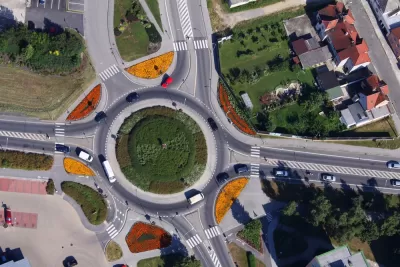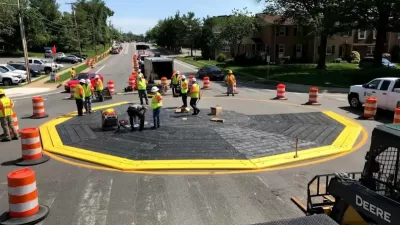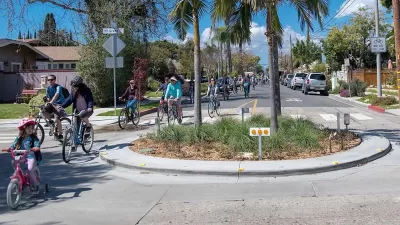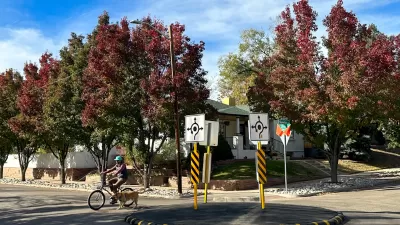Roundabouts, which can dramatically improve traffic safety, have been slowly proliferating across U.S. cities over the last two decades.

Although a lack of federal data makes it difficult to evaluate the scale of their growth, roundabouts and traffic circles are slowly but surely making their way into American cities, writes Andrew Van Dam in the Washington Post.
According to Lee Rodegerdts, who literally wrote the book on roundabouts—Roundabouts: An Informational Guide—there are now roughly 9,000 roundabouts around the country, plus over 160 rotaries and more than 700 traffic-calming circles.
Florida boasts the most roundabouts, but it also has the third-largest population in the nation. Nebraska has the most roundabouts per person, but they’re spread across one of the sparsest (and often most scenic) road networks in the country. Per mile of road, Maryland actually emerges as the roundabout champion.
As far as cities go, the wealthy enclave of Carmel, just outside Indianapolis, has more roundabouts than any other U.S. locality thanks to its long-term mayor, who has championed roundabouts for decades. Carmel has built more than 140 roundabouts under his tenure.
“Why add a roundabout, you might ask. Because roundabouts offer impressive safety gains. In general, a roundabout will drive down fatal crashes by 90 percent and cut all car-crash injuries by at least 75 percent, even while accommodating a higher volume of cars.” The benefit is even greater at rural two-way stops, cutting traffic injuries by as much as 90 percent.
FULL STORY: The rise of the roundabout and which state has the most

Alabama: Trump Terminates Settlements for Black Communities Harmed By Raw Sewage
Trump deemed the landmark civil rights agreement “illegal DEI and environmental justice policy.”

Planetizen Federal Action Tracker
A weekly monitor of how Trump’s orders and actions are impacting planners and planning in America.

The 120 Year Old Tiny Home Villages That Sheltered San Francisco’s Earthquake Refugees
More than a century ago, San Francisco mobilized to house thousands of residents displaced by the 1906 earthquake. Could their strategy offer a model for the present?

San Francisco Opens Park on Former Great Highway
The Sunset Dunes park’s grand opening attracted both fans and detractors.

Oregon Legislature to Consider Transit Funding Laws
One proposal would increase the state’s payroll tax by .08% to fund transit agencies and expand service.

Housing Vouchers as a Key Piece of Houston’s Housing Strategy
The Houston Housing Authority supports 19,000 households through the housing voucher program.
Urban Design for Planners 1: Software Tools
This six-course series explores essential urban design concepts using open source software and equips planners with the tools they need to participate fully in the urban design process.
Planning for Universal Design
Learn the tools for implementing Universal Design in planning regulations.
Clanton & Associates, Inc.
Jessamine County Fiscal Court
Institute for Housing and Urban Development Studies (IHS)
City of Grandview
Harvard GSD Executive Education
Toledo-Lucas County Plan Commissions
Salt Lake City
NYU Wagner Graduate School of Public Service





























